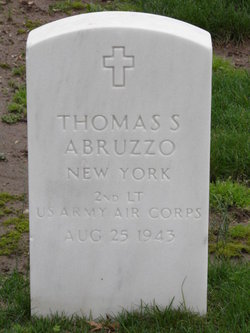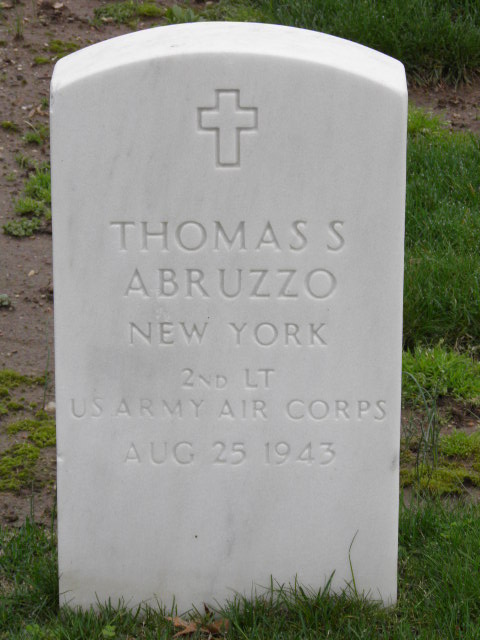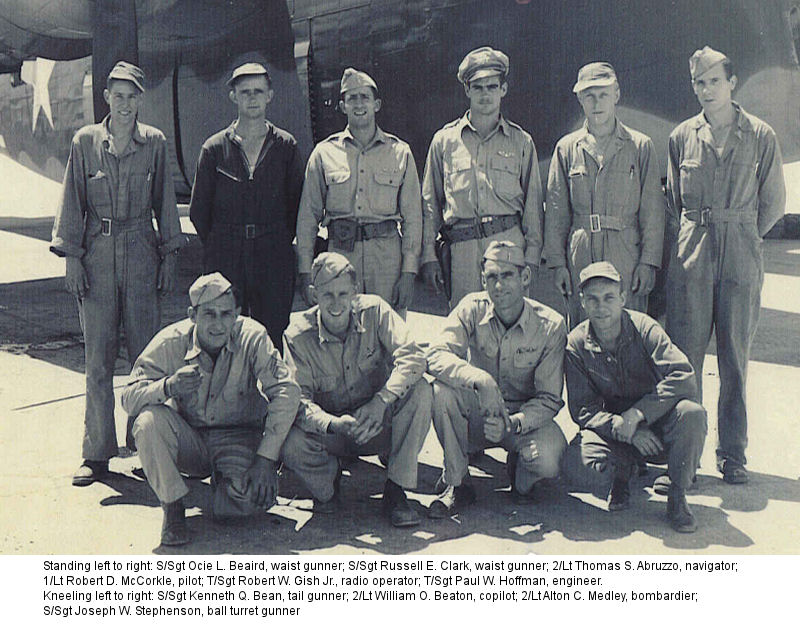Home: New York.
Unit: 576th Bomb Sq 392th Bomb Gp
Service ID: O-744034.
Pilot 1st/Lt. Robert D. McCorkle
Non-Combat Accident Report
Date Lost: 25-Aug-43
Serial Number: #41-29485
Aircraft Model B-24H
Aircraft Letter:
Aircraft Name:
Location: Near Lecompton Kansas
Cause: Mechanical failure
On 25 August 1943, the crew lifted off at 1814 hours from Topeka Army Air Base. The aircraft was brand new, with only 16 hours of air time, and the crew was taking it on a calibration and training mission. According to the Report of Aircraft Accident, "Shortly after take-off, when the propellers were being synchronized, No. 4 propeller ran away. Three of the eight crew members were trapped on the flight deck by the nose wheel and top turret, resulting in fatal injury. No fire resulted."
PLANE IS LANDED IN A CORNFIELD
THREE FLIERS FROM TOPEKA BASE KILLED IN EMERGENCY SET-DOWN WAS NEAR LECOMPTON
Three army fliers are dead as a result of the crash of a heavy bomber from the Topeka Air Base during an attempted emergency landing in a cornfield three miles northwest of Lecompton last evening about 6:30 o'clock. Two of the fliers were killed outright and another died during the night. The five other crewmen were not seriously injured as the big four-motored plane plowed thru the field only a short distance form the Kaw river.
Base public relations officers today listed the dead as 2nd Lieut. Alton C. Medley, bombardier, Harlingen, Tex.; 2nd Lieut. Thomas S. Abruzzo, navigator, Brooklyn, N.Y., and Staff Sgt. Robert W. Gish, Jr., radio operator, Madisonville, KY. A surviving crew member reached a telephone at Lecompton shortly after the crash and notified the Topeka air base of the accident. Army officers reached the crash scene about an hour and a half after the big bomber went down, and a truckload of soldiers arrived a few minutes later to place a guard around the cornfield to keep out spectators. The crash occurred on the Walter Moore farm in a flat field which reaches from the Santa Fe tracks to the river on the north. The large tail fins of the plane, protruding out of the tall corn, were slightly more than a quarter mile north of the railroad tracks.
MOTORS SHUT OFF
Farmers in the neighborhood said they believed the motors of the plane were shut off while the ship was several miles from the crash scene. The pilot apparently attempted to come in for a landing in the field but the large ship plowed along the ground, losing two or more propellers, before it dug its nose into the ground.
Sheriff Roslin Skinner was notified immediately and he was the first officer to reach the field. Ambulances from Rumsey's and Funks answered the call and pulled up within about 100 yards of the disabled plane. An anesthetic was administered to the one man, severely injured, who was caught in the plane and could not be liberated until mechanics arrived. Bodies of the two men killed were not immediately removed. By 9:30 the field was filled with army motor equipment, sent to aid the survivors, keep out spectators, guard against fire, and remove the bodies.
SHERIFF TOOK CHARGE
For about thirty minutes before additional army personnel arrived, Sheriff Skinner and Deputy Elmer Schiller took charge of the scene and held back spectators. They feared the possibility of fire and explosion from gasoline spilled on the ground, and were aware that army investigators would not want civilians making a first hand inspection of the damaged ship. Because of the remoteness of the area, the crash did not attract many spectators. Two hours after the accident not more than 40 civilians were at the field and most of them were neighboring farmers. The Moore farm is on the north side of the old "river road" and is only a short distance east of the farm owned and operatored by George Bahnmaier of the Lawrence National bank. Apparently the accident was witnessed by only one person. Arthur Weidler, operating a tractor, who dismounted in a hurry when he feared he would be hit by the wings of the rapidly descending ship. he was immediately questioned by army authorities.
Crew of #41-29485 killed:
2Lt. Thomas S. Abruzzo Navigator
2Lt. Alton C. Medley Bombardier
TSgt. Robert W. Gish Jr. Radio Operator
Survivors:
1Lt. Robert D. McCorkle Pilot
2 Lt. William O. Beaton Co-Pilot
TSgt. Paul W. Hoffman Engineer
SSgt Joseph W. Stephenson Gunner
SSgt. Ocie L. Beaird Gunner
Home: New York.
Unit: 576th Bomb Sq 392th Bomb Gp
Service ID: O-744034.
Pilot 1st/Lt. Robert D. McCorkle
Non-Combat Accident Report
Date Lost: 25-Aug-43
Serial Number: #41-29485
Aircraft Model B-24H
Aircraft Letter:
Aircraft Name:
Location: Near Lecompton Kansas
Cause: Mechanical failure
On 25 August 1943, the crew lifted off at 1814 hours from Topeka Army Air Base. The aircraft was brand new, with only 16 hours of air time, and the crew was taking it on a calibration and training mission. According to the Report of Aircraft Accident, "Shortly after take-off, when the propellers were being synchronized, No. 4 propeller ran away. Three of the eight crew members were trapped on the flight deck by the nose wheel and top turret, resulting in fatal injury. No fire resulted."
PLANE IS LANDED IN A CORNFIELD
THREE FLIERS FROM TOPEKA BASE KILLED IN EMERGENCY SET-DOWN WAS NEAR LECOMPTON
Three army fliers are dead as a result of the crash of a heavy bomber from the Topeka Air Base during an attempted emergency landing in a cornfield three miles northwest of Lecompton last evening about 6:30 o'clock. Two of the fliers were killed outright and another died during the night. The five other crewmen were not seriously injured as the big four-motored plane plowed thru the field only a short distance form the Kaw river.
Base public relations officers today listed the dead as 2nd Lieut. Alton C. Medley, bombardier, Harlingen, Tex.; 2nd Lieut. Thomas S. Abruzzo, navigator, Brooklyn, N.Y., and Staff Sgt. Robert W. Gish, Jr., radio operator, Madisonville, KY. A surviving crew member reached a telephone at Lecompton shortly after the crash and notified the Topeka air base of the accident. Army officers reached the crash scene about an hour and a half after the big bomber went down, and a truckload of soldiers arrived a few minutes later to place a guard around the cornfield to keep out spectators. The crash occurred on the Walter Moore farm in a flat field which reaches from the Santa Fe tracks to the river on the north. The large tail fins of the plane, protruding out of the tall corn, were slightly more than a quarter mile north of the railroad tracks.
MOTORS SHUT OFF
Farmers in the neighborhood said they believed the motors of the plane were shut off while the ship was several miles from the crash scene. The pilot apparently attempted to come in for a landing in the field but the large ship plowed along the ground, losing two or more propellers, before it dug its nose into the ground.
Sheriff Roslin Skinner was notified immediately and he was the first officer to reach the field. Ambulances from Rumsey's and Funks answered the call and pulled up within about 100 yards of the disabled plane. An anesthetic was administered to the one man, severely injured, who was caught in the plane and could not be liberated until mechanics arrived. Bodies of the two men killed were not immediately removed. By 9:30 the field was filled with army motor equipment, sent to aid the survivors, keep out spectators, guard against fire, and remove the bodies.
SHERIFF TOOK CHARGE
For about thirty minutes before additional army personnel arrived, Sheriff Skinner and Deputy Elmer Schiller took charge of the scene and held back spectators. They feared the possibility of fire and explosion from gasoline spilled on the ground, and were aware that army investigators would not want civilians making a first hand inspection of the damaged ship. Because of the remoteness of the area, the crash did not attract many spectators. Two hours after the accident not more than 40 civilians were at the field and most of them were neighboring farmers. The Moore farm is on the north side of the old "river road" and is only a short distance east of the farm owned and operatored by George Bahnmaier of the Lawrence National bank. Apparently the accident was witnessed by only one person. Arthur Weidler, operating a tractor, who dismounted in a hurry when he feared he would be hit by the wings of the rapidly descending ship. he was immediately questioned by army authorities.
Crew of #41-29485 killed:
2Lt. Thomas S. Abruzzo Navigator
2Lt. Alton C. Medley Bombardier
TSgt. Robert W. Gish Jr. Radio Operator
Survivors:
1Lt. Robert D. McCorkle Pilot
2 Lt. William O. Beaton Co-Pilot
TSgt. Paul W. Hoffman Engineer
SSgt Joseph W. Stephenson Gunner
SSgt. Ocie L. Beaird Gunner
Inscription
2LT, 576 AAF BOMB SQ WORLD WAR II
Sponsored by Ancestry
Advertisement
Explore more
Sponsored by Ancestry
Advertisement



